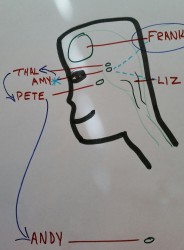From one of my most popular emails!
When we launch into sharing information with our clients about how the brain works and what happens in our body when we get upset, our client’s eyes may glaze over, lost in the unfamiliar words we use: Amygdala, hypothalamus, Pituitary Gland, Frontal Cortex, adrenalin, epinephrine, etc. I have attempted to simplify it with the following story I keep on my desk and, when appropriate, share a variation of this, granted oversimplified, story.
When Amy Gets Upset
Our body is like a community and several members play a critical role in creating our upsetting reactions: four in the brain, one just outside the brain, and one on top of the kidneys. All these parts work together. We’ll give them nicknames.
Once a threat, real or imagined, is identified by Frank, the prefrontal cortex, or Liz, our brain stem, they send a message to Amy, the amygdala. Amy is small and has only one very important job, to broadcast the alarm whenever a message of “danger” is received. Amy responds whether the “threat” is a real external threat to the body or “self” or merely perceived internally as threatening.

Amy receives a message and sends a warning – sort of like turning all the lights on in the house in the middle of the night. Then, like a local volunteer fire department, Thal, the hypothalamus, is nearby and sees those blazing lights and immediately informs Pete, the pituitary gland. Pete begins making and distributing emergency chemicals, getting the body ready for fight or flight. One of those chemicals wakes up Andy, a more distant neighbor, the adrenal gland, who then begins to release the storehouse of “ammunition” necessary for the other parts of the body to maximize their ability to fight or flee.
Let’s look at that process again: Amy is triggered to turn on the alarm by the message from Liz or Frank. It could be just the perception of outside danger by Liz, the earliest resident of the brain, who’s very old and not always a team player. An example of outside danger would be walking along the street. You hear a dog bark very close by. It sounds big and vicious. Instantaneously, you are alert, your heart pounds, your breath becomes shallow, you sweat – all from Amy’s (your amygdala) signal. Your body reacts when Thal signals Pete and Andy (the hypothalamus sends chemical messages to the pituitary and adrenal glands) and Liz (your brain stem) to react as rapidly as possible. Only when you realize the large dog is behind a tall fence does Frank (your prefrontal brain) say… “you are safe” and the body calms.
Or perhaps Frank, the cognitive part of the brain, simply had a negative thought, or something happened that while currently not a threat, seems to Frank to be a similar situation in which there was actual danger either to the physical body or to the sense of identity. Any sort of negative, limiting thought, “Let’s not try that again, it hurt too much last time.” or “Oh, no!” or “You can’t do that.” or “Doing that is too risky” etc. are also messages to Amy to hit that alarm.
Amy is a key part of an instinctive, powerful, primitive, and automatic defense system, the first within the body to respond to any threat – real or perceived. Amy does not question, assess, or evaluate, the meaning of the threatening “message” – again real or perceived. Amy responds.
The amygdala (Amy) simply turns on the alarm. It is then the hypothalamus (Thal) alerts the pituitary gland (Pete) who sends a chemical warning to the adrenal glands (Andy) to start pumping chemicals throughout the body. With the increase of these chemicals, the body tends to become anxious and fearful – maybe even panicked.
Whose job is it to make an evaluation of the situation, to decide if there is real danger or if it is a false message? Not Liz or Amy or Thal, or Pete or Andy!
The prefrontal cortex (Frank) is responsible for problem solving and judgment. Frank can be very rational and logical and reality-oriented. Frank could evaluate whether the danger is real, or false – as happens all too often with folks who have chronic panic attacks or anxiety. The problem? When the body is on high alert (emotionally upset) Frank cannot function well. He assesses the situation after the danger is gone. As long as the danger is there, the resources of the body are diverted, and Frank is “put on hold” and loses much of his cognitive abilities. All this means we are not thinking clearly when aroused or upset.
In a danger situation, chemicals like epinephrine flowing within the body convince Frank that there really is danger; it sure feels like it! Frank shuts down to leave as much energy as possible for the rest of the body to react. Now the body is on a chemically propelled loop of a roller coaster ride – the voluntary fire department is spraying chemicals everywhere.
At what point does Frank look at the reality of the situation and tell Amy to back down, “Nope, just kidding, false alarm?” That is part of the problem. We have seen that when outside threat is no longer perceived as a threat, Frank easily re-evaluates it. But when the threat is from the inside, Frank often continues to send negative cognitions, e.g. “Oh, no!” “You can’t handle this.” signals, to Amy, even when there is no real danger. Such messages work well to stop us from pursuing our goals in life. These messages block us from thinking clearly and from seeing realistic options.
As babies, our brains began the process of “hardwiring” in our responses. Once a reaction is firmly established, we often react automatically. The limbic system responds much faster than the slower deliberation of the cortex. The more trauma in the past, the more Frank may need outside help to assess the situation and calm.
Another challenge is that even after Frank gives an all-clear message, Pete and Andy, the pituitary and adrenal glands, have aroused the entire sympathetic nervous system; they have done a good job of “spraying” chemicals everywhere. And, as long as they continue doing so, like in a vicious circle, Frank won’t be able to stop Amy’s reaction.
The sympathetic system, the fight or flight part of our body was activated with all those chemicals, and once aroused it is slow to back down. The parasympathetic nervous system – the relaxing part – also takes its sweet time to engage. This is, of course, why typical relaxation attempts, and sometimes EFT as well, aren’t always immediately effective. And with chronic high arousal in the body, additional tools, encouragement, and practice are needed to be able to evaluate the reality of the danger signal. In addition to education, empathy, encouragement, longer processing time, and reinforcement for practicing new skills may also be needed.

While we don’t know the exact “something” that happens with EFT, tapping often results in calming the body and resolving chronic reactions to “false” messages. Our body calms. We are able to “think more clearly about our problem.” We can explore and practice other ways of reacting. We gain more sense of self-control and empowerment.
NOTE: Because we often grasp things better visually, in a face-to-face session this story is accompanied by a rough drawing. Rough being the operative word here! Obviously, I am not in the group of people who have significantly “more grey matter in an area of the brain called the precuneus in the parietal lobe.” We call them Artists. * <smile>
* http://www.bbc.com/news/science-environment-26925271
Share the URL link for this post on Facebook and others you feel would be interested.
AND, Like this post? Want more helpful suggestions in your email box each week??
Sign up on the right for my weekly emails and bonus downloads.










4 responses to “When Amy Gets Upset – Brain Science Simplified”
This is a great article, Ann! Love it! And it makes the information really personal, which is to say, accessible! Keep up the fabulous work!
Beautiful job Ann. You contribute so much to this wonderful work. Thank you for all you do.
Hi Ann,
This story is a story which everyone can understand-even kids.
I give a talk on EFT next week and am going to demonstrate your presentation.
Very clever. Love it and a bunch of thanks for it.
Light and Gratitude,
Li-Aura.
Good article well done